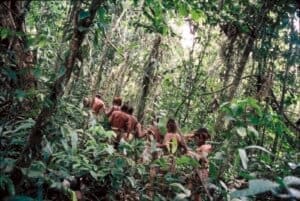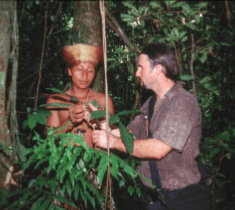The pathway that winds from our Oregon laboratory courses through acres of cedars and oaks, sedges and ferns. With an average of 17 tree species per acre, the mountains of Southern Oregon are often touted as the richest flora in the western USA.
In the jungles of Amazonia, a journey of 5 thousand miles from my home where I am often cast into research – a thriving botanical Eden sprouts from nearly infertile and cloying wet soils; almost all of it unsuitable for human endeavors of agriculture and ranching. There, from a single hectare of soil, nearly 300 species of trees and 4,000 other angiosperms thrive in a complex ecology.
 In a vertical rise to the cloud forest and puna, the 16,000 foot ridges of the Andes peak over our Amazon farm-a course of just fifty miles. In this short journey, the world’s greatest taxonomists have counted more than 30,000 botanical species, each manufacturing a unique chemical matrix and offering a genuine affiliation for its specific niche; a true altruism for the humans lucky enough to abound there.
In a vertical rise to the cloud forest and puna, the 16,000 foot ridges of the Andes peak over our Amazon farm-a course of just fifty miles. In this short journey, the world’s greatest taxonomists have counted more than 30,000 botanical species, each manufacturing a unique chemical matrix and offering a genuine affiliation for its specific niche; a true altruism for the humans lucky enough to abound there.
Throughout Amazonia, be it the puna or the lowland plains, the crenelation of green is, in actuality, a laboratory filled to its brim. As the equatorial elements meld (heat, and a continuous humidity that soars above 95 percent), the forces of nature conjoin by some great fate with the emergence of Amerindian culture and what is considered the wealthiest body of botanical treasure on earth. Be it a miracle in progress or chaos that took form and sprouted into good fortune by happenstance, to Amazonia and to the children who credit their origins there; we owe much homage.
To many who dwell there, Amazonia is a healing forest, filled with medical botany, a staggering medical pharmacopeia that exists today in almost unimaginable proportions.
From what might have originally seemed only a riot of foreboding wilderness. The combination of chemistry and pharmacology and parapsychology gave rise to a venerable lineage of highly trained medical practitioners, all of them accomplished doctors, nurses, psychologists, and spiritual counselors. Many of them are directly descended from medical experts who spent two thousand years crafting and defining a medicinal pharmacology that predates written history.
“Dozens of these plant-based drugs (medical botany) are now fractioned by chemists and are deemed so intricate and chemically profound – so exacting in their function that-as one scientist put it, “impossible for any scientist to copy in a laboratory let alone ‘imagine’!”
Today this pharmakon is resplendent and replete with systems of internal medicine. Here an entire ‘whole patient’ healing tradition is as precise and practiced as any in the West. This medical botany pharmacy continues to beckon and allure philosophers and chemistry wizards of our new medical era.
In Amazonia past, and of present, Curanderos, Shamans or ‘Savages’-no matter how they were known-were actually masters of psychology, nutrition, and the application of medical botany with botanical medicines.
They devised multi-step systems for extracting thousands of beneficial drugs and compound formulations directly from the forest. With delivery systems so novel, even today these drugs produce actions that rival modern medications. These are the essential materia prima for stunning new phytochemical contributions.
Dozens of these plant-based drugs are now fractioned by chemists and are deemed so intricate and chemically profound -so exacting in their function-that, as one scientist put it, “impossible for any scientist to copy in a laboratory let alone ‘imagine’!”
Understanding and unraveling the phytochemical components and the fine art of enticing easily assimilated extracts, tonic emollients, teas, lotions and internal pro-biotics from plants ripe with vital life energies is no small task rushed by a single lifetime.
 From midwife to master healer, Amazon Amerindians parlayed in a language which was attuned to the sensitivity of botanical nuances. They consciously accelerated the advancement of their medical system by astute training, which in many cases lasted decades before graduation. Many of their medical botany compounds are still so little understood in their actions that they seem to dance only as a vision on an ethereal plane, leaving science baffled as to their methods of action, and still others, with no apparent function at all but to serve as an adjunct to healing by awakening the intuition and pointing both ‘healer and patient’ to the very origin of disease itself. Genius indeed.
From midwife to master healer, Amazon Amerindians parlayed in a language which was attuned to the sensitivity of botanical nuances. They consciously accelerated the advancement of their medical system by astute training, which in many cases lasted decades before graduation. Many of their medical botany compounds are still so little understood in their actions that they seem to dance only as a vision on an ethereal plane, leaving science baffled as to their methods of action, and still others, with no apparent function at all but to serve as an adjunct to healing by awakening the intuition and pointing both ‘healer and patient’ to the very origin of disease itself. Genius indeed.
Still, other botanical drugs are now only emerging into literature and are certain to startle medicinal communities as reports of their actions are “finally ‘proven’ in clinical trials.” Many drugs are already found to be especially effective in the treatment of chronic illness and reversing degenerative disease. Others are complementary to that, targeting the spiritual imbalances that were recognized as the cause of most illness.
By the time of the ‘discovery’ of South America by Europeans, more than 8 million inhabitants were living in the Amazon jungle. Their herbology, homeopathy, and psychiatry had become honed into an impressive, methodological system of fine arts. More impressive, these sciences were preserved and have been passed down in makeshift schools through storytelling by elder ‘curanderos.’ They gathered impressive tomes of knowledge and stowed it, not in books, but into the fabric of oral tradition. Today, this is a voluminous medical heritage only beginning to metamorphose and assimilate into hundreds of studies ongoing in western universities and private laboratories.
While western scientists have refined the ability to classify and name novel plant-based alkaloids, terpenes, and flavonoids, thus accelerating the pace of empirical studies and subsequent release of new drugs and technologies; many of which were exotic, new or had identical chemical fractions including complicated matrixes and beneficial metabolites, all found in plants-have previously been depicted and prescribed by a long lineage of unlettered (“uneducated”) indigenous Amazon healers.
A living laboratory, the Amazon’s healing pharmakon unfolds as new species of plants are identined almost weekly. In the western Amazon, Tapiipiscu tribes offer a lesson in trust and generosity to Jerome R.
Black. Their empirical data and traditional remedies are selected for further testing
in western laboratories.
In the last few years, I have taken refuge in jungly biomes, working from huts or small boats and languishing even more uncomfortably on university campuses or private institutes throughout South America. I have felt the need to show a connection between clinical trials, documented university-level research and the actual ethnobotanical data from fieldwork that was provided to me by the great physicians who still abide in the heart of the jungle. This work combines empirical data from a thousand years of popular use into a highly potentiated and complex potion. This is, indeed, the Amazon’s materia medica, and it far surpasses a few years of trials that the FDA now devotes to the approval of a synthetic laboratory drug, each with its own eager corporation backing it. Some drugs created in the West are now rushed though FDA screening and sold with copious warnings, hedging the corporate bet should some untoward actions liable them for ‘misuse’ of ‘their’ drugs. Thankfully, hundreds of well-known proponents of natural medicines provide validation in their clinical practices. As Dr. James Duke, Dr. Wiel and others refrain, “the body is more attuned to receiving and complying with natural medicine than synthetic ones.”
Fortunately, accurate accounts of formulation and precise dosage, the applications, and methodologies of maintenance therapies of Amazon medicine have been faithfully recorded by a magnificent oral tradition and colorful and medical lexicon.
Today, the evidence is clear. Amazon healers and their rich medical botany apothecary provide immutable assets to modern-day clinicians and practitioners.
Clinical trials and university-level research are revealing the unshakable grasp Amazon healers have placed upon their natural pharmaceuticals and all they have to offer modern sciences.
The hard-won knowledge of correct diagnosis, followed by the correct use of the medicaments has proven as accurate and bold as many of the internal medicines and practices of the West. And to that, we lift our cup.
Herein, find documented herbal treatments, powerful drug compounds, and clinical validation that ingratiates Amazon medicines even further into the guarded circles of the allopathic physician. Together, hand in hand with science and new technologies, we begin an exploration into a system of medicine that once began as a process of ‘healing’ direct from the heart of the jungle.’ And long may it live.

Reader Interactions